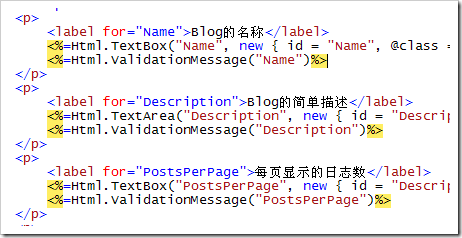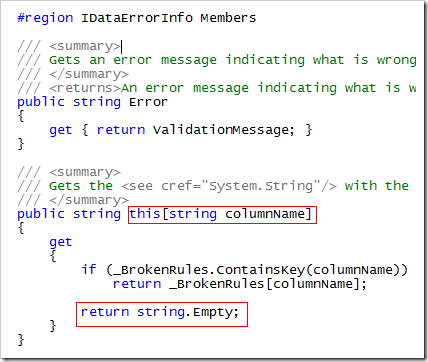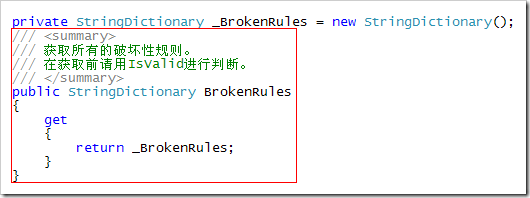ASP.NET MVC 入门7 ModelState与数据验证
ViewData有一个ModelState的属性,这是一个类型为ModelStateDictionary的ModelState类型的字典集合。在进行数据验证的时候这个属性是比较有用的。在使用Html.ValidationMessage()的时候,就是从ViewData.ModelState中检测是否有指定的KEY,如果存在,就提示错误信息。例如在前一篇文章ASP.NET MVC 入门7、Hellper与数据的提交与绑定中使用到的UpdateModel方法:
我们在View中使用Html.ValidationMessage(string modelName)来对指定的属性进行验证:
Html.ValidationMessage()有几个重载:
其中ValidationSummary()是用于显示全部的验证信息的。跟ASP.NET里面的ValidationSummary验证控件差不多。
我们测试一下/Admin/Setting页面:
在用UpdateModel方法更新BlogSettings.Instance.PostsPerPage的时候,当我们如图所示填写"10d"的时候,由于PostsPerPage为整型的,所以UpdateModel方法就会出错,同时会往ViewData.ModelState添加相应的错误信息,从而Html.ValidationMessage()方法就可以从ViewData.ModelState中检测到错误并提示。同时Html.ValidationMessage()方法会为出错的属性的输入框添加一个名为"input-validation-error"的CSS类,同时后面的提示信息的CSS类名为"field-validation-error":
CSS类的样式是可以由我们自己自由定义的。如上图的红色高亮显示。
好,下面我们来实现发表新随笔的功能。我们先写一个提供用户输入随笔内容的表单页面:
< label for ="Title" > 标题 </ label >
<% = Html.TextBox( " Title " , new { id = " Title " , @class = " required " }) %>
<% = Html.ValidationMessage( " Title " ) %>
</ p >
< p >
< label for ="Content" > 内容 </ label >
<% = Html.TextArea( " Content " ) %>
<% = Html.ValidationMessage( " Content " ) %>
</ p >
< p >
< label for ="Slug" > URL地址别名(如果为空则和标题同名) </ label >
<% = Html.TextBox( " Slug " , new { id = " Slug " , @class = " required " }) %>
<% = Html.ValidationMessage( " Slug " ) %>
</ p >
然后我们对用户提交过来的数据进行保存:
public ActionResult SaveNewPost(FormCollection form)
{
Post post = new Post();
try
{
UpdateModel(post, new [] { " Title " , " Content " , " Slug " });
}
catch
{
return View(post);
}
post.Save();
return ShowMsg( new List < string > () { " 发表新随笔成功 " });
}
由于这三个值都是字符串类型,所以如果值为空的话,UpdateModel也是不会出错的,而我们的Title和Content是不允许为空的,或者我们想我们的Slug的长度不能超过100,也就是需要有我们自己的业务规则。这时候我们或许会这样写:
{
UpdateModel(post, new [] { " Title " , " Content " , " Slug " });
}
catch
{
return View(post);
}
if ( string .IsNullOrEmpty(post.Title))
{
ViewData.ModelState.AddModelError( " Title " , post.Title, " 标题不能为空 " );
}
if ( string .IsNullOrEmpty(post.Content))
{
ViewData.ModelState.AddModelError( " Content " , post.Content, " 内容不能为空 " );
}
if ( ! ViewData.ModelState.IsValid)
{
return View(post);
}
ViewData.ModelState提供了一个AddModelError的方法,方便我们添加验证失败的信息。我们可以如上代码这样进行对象的业务规则验证,但是一旦业务规则多了,这样的代码是非常壮观的,而且不好控制。那么我们该怎么更好的进行业务规则的验证呢?得意于BlogEngine.Net的良好架构,我们可以很轻松的完成这一点。
首先,让我们修改一下BlogEngine.Core里面BusinessBase的代码。我们前面说过,BusinessBase实现了IDataErrorInfo接口,该接口有个索引器,导致ViewData.Eval()方法调用时搜索索引器的值时返回String.Empty而使ViewData.Eval()认为是找到值了,从而失效。
我们可以将return string.Empty修改为return null。但我们这里并不需要用到这个接口,所以我们把该接口去掉,并把相应的代码注释了。然后我们再暴露一个BrokenRules的属性,用于返回当前的所有破坏性业务规则(红框部分代码为我们添加的):
BusinessBase提供了一个抽象的ValidationRules方法,用于在业务类重写这个方法往里面添加验证规则(具体请看BusinessBase的Validation节)。
我们在Post类中重写这个方法来添加验证规则:
然后我们可以在Controller的Action中很优雅的书写我们的代码来进行业务规则的验证:
public ActionResult SaveNewPost(FormCollection form)
{
Post post = new Post();
try
{
UpdateModel(post, new [] { " Title " , " Content " , " Slug " });
}
catch
{
return View(post);
}
if ( ! post.IsValid)
{
foreach ( string key in post.BrokenRules.Keys)
{
ViewData.ModelState.AddModelError(key, form[key], post.BrokenRules[key]);
}
return View(post);
}
post.Save();
return ShowMsg( new List < string > () { " 发表新随笔成功 " });
}
我们注意到上面的Action中用到了一个FormCollection 的参数,这个参数系统会自动将Form提交过来的全部表单值(Request.Form)赋给它的。客户端验证可以用jQuery的验证插件来,这里就不罗嗦了。
本文的Blog程序示例代码: 4mvcBlog_8.rar







